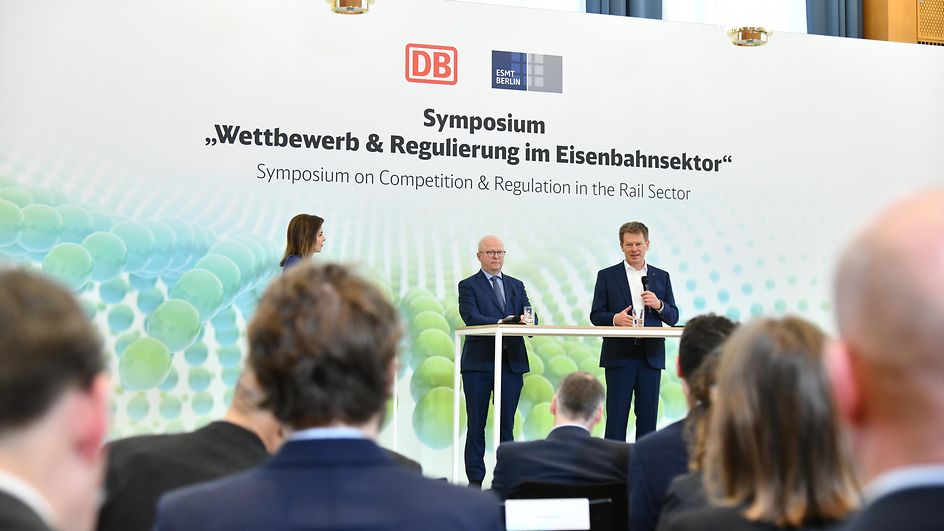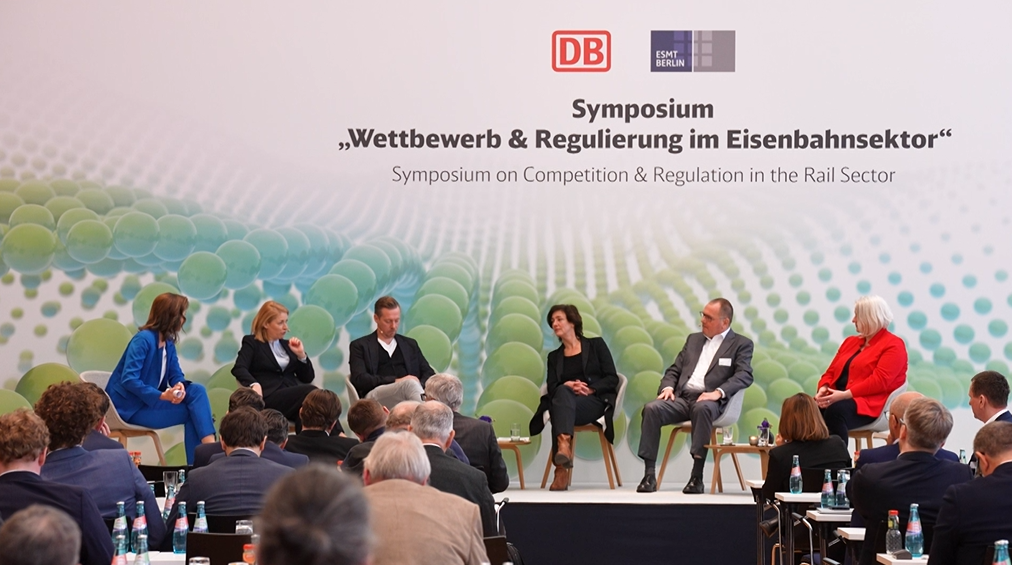Competition Symposium
The 1st of January 2024 marks the 30th anniversary of the German Rail Reform. It was the perfect opportunity for us to take stock at the 17th Symposium on Competition & Regulation in the Rail Sector on 25 January 2024 and to discuss what still needs to be done to achieve current transport policy objectives. Specifically, we need to increase rail freight's market share to 25% and double transport volume in rail passenger transport. It was clear from the presentations and discussions that increasing infrastructure capacity, which includes improving utilisation, is absolutely essential if we are able to achieve these objectives.
According to DB CEO Richard Lutz, competition on the railways, which began with the German Rail Reform in 1994, has been a success. A new dynamic and greater customer focus have helped rail transport to grow. More trains travel on DB's rail network now than ever before. The reform's aim of reducing the burden on the federal budget was also achieved in the phase following the Rail Reform. Lutz said there was downside, however: Too little investment in rail infrastructure to keep pace with growth and enable further growth. DB and the German government are taking systematic action to rectify this. The core task of DB InfraGO AG, which was established as a public service-oriented company on 1 January 2024, is to manage, develop and expand the rail network and stations from a single source. Lutz emphasised that the way to a strong rail system is through a strong infrastructure.
Giving the infrastructure a public service orientation is the biggest reform step since 1994, according to Michael Theurer, German Federal Government Commissioner for Rail Transport. In addition, the German rail network needs a new and transparent funding architecture, he said. This was also one of the key proposals of the German Rail Acceleration Commission. The way to achieve this is via a rolling multi-year infrastructure plan based on the Austrian model. Above all, future mobility must be climate-neutral and energy-efficient, and it will be multimodal, Theurer added. When we look at society, putting the rail sector at the centre could help to attract more skilled workers, he said.
Filip Negreanu-Arboreanu, Head of EU Transport Commissioner Adina Vălean's Cabinet, explained what European transport policy can do to help create the infrastructure capacity needed in order for climate-friendly rail transport to grow. The Commission has written the recipe for a clean and resilient transport system with its Sustainable and Smart Mobility Strategy, he said. Rail has an important role to play here. It is also essential to win private investment for infrastructure and improve the rail's competitive strength, Negreanu-Arboreanu said. The potential of digitalisation and automation must be used for this. The Commission's proposal for a regulation on the use of railway infrastructure capacity in the Single European Railway Area has highlighted one way to improve the use of existing infrastructure.
Herbert Kasser, Secretary General of the Austrian Federal Ministry for Climate Action, Environment, Energy, Mobility, Innovation and Technology, provided insight into Austria's infrastructure policy. The strategic direction of Austria's Mobility Master Plan adopted in 2021 is to avoid, shift and improve transport. Kasser explained that Austria's infrastructure planning and financing architecture consists of three central instruments: the target network as a long-term strategy for expanding rail infrastructure, framework plans for the medium term, and financing agreements, which will fund the successive implementation of the target network. The six-year framework plan for the ÖBB-Infrastruktur AG network will be prepared annually and updated as needed. The plan is a rolling plan and each year will be extended by one additional year. It covers measures to be implemented within six years and includes all investments for new-build and upgrade projects, reinvestment and programmes for the existing network (ETCS, accessibility, digitalisation, etc.), Kasser added. The framework plan also includes all expenses for maintenance, inspection and servicing. The Ministry will enter into funding agreements with ÖBB-Infrastruktur AG, which will make the plans legally binding, he said. The funding agreements will also have a term of six years and will need to be approved by the legislature every year. The result is planning security and commitment for all parties involved. The continuous reliable infrastructure policy will make an impact, Kasser said. Rail freight transport currently has a roughly 30% modal split, which should increase to 40% over the long term. The same goal has been set for public transport (bus and rail), he added.
At the panel discussion on capacity allocation in the future, Dr Wilhelm Eschweiler, Vice President of the German Federal Network Agency for Electricity, Gas, Telecommunications, Post and Railway; Dr Philipp Nagl, Chair of the Management Board of DB InfraGO AG; Neele Wesseln, Managing Director of Die Güterbahnen; and Michael Mittag, Director Network Planning & Market Access FLIXTRAIN; discussed how to maximize infrastructure capacity. In his introductory statement, Eschweiler emphasised that optimal capacity planning and allocation must take the needs of users into account as far as possible – and that the same is true for the quality of operations. The European Commission's draft regulation creates an opportunity to make rail transport more efficient throughout Europe, he said. Implementing rolling plans and master agreements simultaneously could better accommodate different transport needs. Users and other infrastructure managers that are affected should be able to actively influence strategic planning as early as the concept design phase, he said.
In the discussion that followed, Wesseln confirmed that it was absolutely essential to involve companies. She stated that above all, plans should better reflect the needs of the different modes of transport. Rail freight transport has different requirements than passenger transport, she said. According to Wesseln, ad hoc service accounted for around 30% of train path orders in German rail freight transport, and capacity needs to be reserved in advance. Mittag urged more transparency. The railways have business responsibility and must also be able to determine routes in order to align their services with customer demand. Rail companies need to know the available capacity and possible restrictions in order to optimise train path orders, he said.
With regard to calls for better operating quality, Nagl emphasised the trade-off between the objective of shifting more traffic to rail and improving operating quality. Increasing traffic on congested routes and at nodes comes at the expense of quality. In order to restore quality, the focus must be on modernising and renewing the existing network. New construction and expansion is the right thing to do, and it is important, he said. However, the existing network is what determines capacity and quality. Mittag stressed that refurbishment of existing structures and new builds and upgrades must happen at the same time. Wesseln explained that it won't be feasible for rail to achieve a 25% market share without the necessary expansion and continuing electrification of the infrastructure.
To get more freight transport onto the railways, Wesseln also called for fair competition among the modes, promotion of innovation and better management control of DB by the German government. The German government is establishing a new control instrument with its Infraplan. Nagl emphasised that the Infraplan was an important instrument for creating transparency and commitment. In his view, the plan should look ahead and highlight what is needed to keep the 33,000 kilometre network performing. In terms of the most important systems, such as interlockings and switches, he said that the plan should specify the number of facilities to be modernised and replaced each year.
Participants were also critical of potential increases in track access charges, which would affect rail freight and long-distance rail transport in particular. According to Mittag, they would overburden non-subsidised companies, inhibit investment, and hinder market entry and could lead to a thinning out of services. Wesseln warned that the freight railways were also facing economic imbalances caused by the possible track access charge increases combined with the reduction in track access charge funding by the federal government and the poor quality of the network. Loaders will not pay higher prices if the quality is not good, she said. Nagl called it a "defect in the system" that resulted from the capping of track access charges in local rail passenger transport. Because of this, track access charges in this transport segment cannot be adjusted to actual cost developments. The resulting shortfall would require an above-average price increase in the other modes of transport, which the market wouldn't tolerate, he said. The panellists called for a solution, given that both the industry and policymakers are committed to achieving the desired modal shift.

